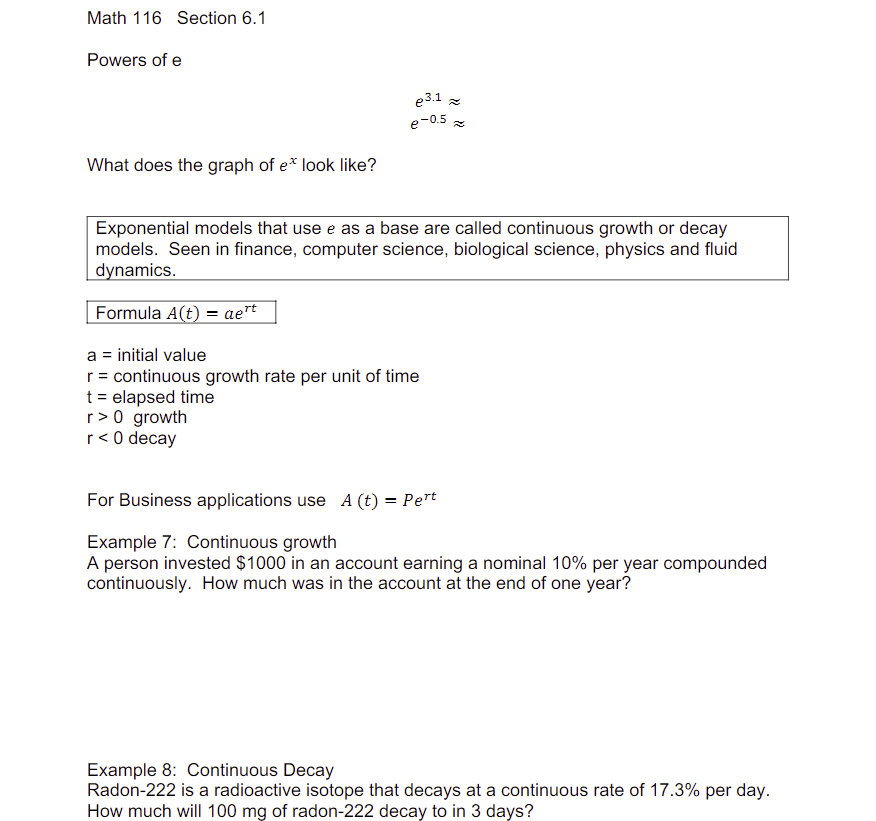Math 116 Section 6.1 Powers of e What does the graph of e* look like? e3.1 ≈ e-0.5 Exponential models that use e as a base are called continuous growth or decay models. Seen in finance, computer science, biological science, physics and fluid dynamics. Formula A(t) = aert a = initial value r = continuous growth rate per unit of time t = elapsed time r> 0 growth r< 0 decay For Business applications use A (t) = Pert Example 7: Continuous growth A person invested $1000 in an account earning a nominal 10% per year compounded continuously. How much was in the account at the end of one year? Example 8: Continuous Decay Radon-222 is a radioactive isotope that decays at a continuous rate of 17.3% per day. How much will 100 mg of radon-222 decay to in 3 days?
Math 116 Section 6.1 Powers of e What does the graph of e* look like? e3.1 ≈ e-0.5 Exponential models that use e as a base are called continuous growth or decay models. Seen in finance, computer science, biological science, physics and fluid dynamics. Formula A(t) = aert a = initial value r = continuous growth rate per unit of time t = elapsed time r> 0 growth r< 0 decay For Business applications use A (t) = Pert Example 7: Continuous growth A person invested $1000 in an account earning a nominal 10% per year compounded continuously. How much was in the account at the end of one year? Example 8: Continuous Decay Radon-222 is a radioactive isotope that decays at a continuous rate of 17.3% per day. How much will 100 mg of radon-222 decay to in 3 days?
Algebra & Trigonometry with Analytic Geometry
13th Edition
ISBN:9781133382119
Author:Swokowski
Publisher:Swokowski
Chapter5: Inverse, Exponential, And Logarithmic Functions
Section: Chapter Questions
Problem 6DE
Related questions
Question

Transcribed Image Text:Math 116 Section 6.1
Powers of e
What does the graph of e* look like?
e3.1 ≈
e-0.5
Exponential models that use e as a base are called continuous growth or decay
models. Seen in finance, computer science, biological science, physics and fluid
dynamics.
Formula A(t) = aert
a = initial value
r = continuous growth rate per unit of time
t = elapsed time
r> 0 growth
r< 0 decay
For Business applications use A (t) = Pert
Example 7: Continuous growth
A person invested $1000 in an account earning a nominal 10% per year compounded
continuously. How much was in the account at the end of one year?
Example 8: Continuous Decay
Radon-222 is a radioactive isotope that decays at a continuous rate of 17.3% per day.
How much will 100 mg of radon-222 decay to in 3 days?
Expert Solution
This question has been solved!
Explore an expertly crafted, step-by-step solution for a thorough understanding of key concepts.
This is a popular solution!
Trending now
This is a popular solution!
Step by step
Solved in 3 steps with 3 images

Recommended textbooks for you

Algebra & Trigonometry with Analytic Geometry
Algebra
ISBN:
9781133382119
Author:
Swokowski
Publisher:
Cengage

Trigonometry (MindTap Course List)
Trigonometry
ISBN:
9781337278461
Author:
Ron Larson
Publisher:
Cengage Learning


Algebra & Trigonometry with Analytic Geometry
Algebra
ISBN:
9781133382119
Author:
Swokowski
Publisher:
Cengage

Trigonometry (MindTap Course List)
Trigonometry
ISBN:
9781337278461
Author:
Ron Larson
Publisher:
Cengage Learning


Big Ideas Math A Bridge To Success Algebra 1: Stu…
Algebra
ISBN:
9781680331141
Author:
HOUGHTON MIFFLIN HARCOURT
Publisher:
Houghton Mifflin Harcourt

Algebra and Trigonometry (MindTap Course List)
Algebra
ISBN:
9781305071742
Author:
James Stewart, Lothar Redlin, Saleem Watson
Publisher:
Cengage Learning
